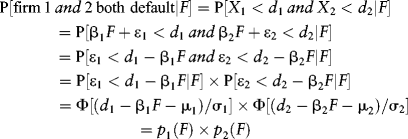11.7 Static Models—Threshold and Mixture Frameworks
Threshold and Bernoulli Mixture Models
The static (fixed time period) structural models discussed in Section 11.5 were formulated as threshold models: default (or ratings transition) occurs when a critical variable X crosses below a critical threshold d. Joint default for two firms is determined by the joint probability that both threshold variables are below their respective critical thresholds:
![]()
In many cases, the Xi are assumed jointly normal so that this is a statement about a bivariate (or for more than two, multivariate) normal distribution.
When the threshold variables are formulated using the common factor structure of (11.15), the model can alternatively be represented as a Bernoulli mixture model. Bernoulli mixture models have a number of advantages, particularly for simulation and statistical fitting (cf. McNeil, Frey, and Embrechts 2005, section 8.4).
The definition for the common factor structure is equation (11.15), reproduced here.
(11.15)![]()
Conditional on F, the threshold variables Xi are independent because the εi are independent. This means the joint default process is independent, conditional on F:

where the final-but-two ...
Get Quantitative Risk Management: A Practical Guide to Financial Risk, + Website now with the O’Reilly learning platform.
O’Reilly members experience books, live events, courses curated by job role, and more from O’Reilly and nearly 200 top publishers.

